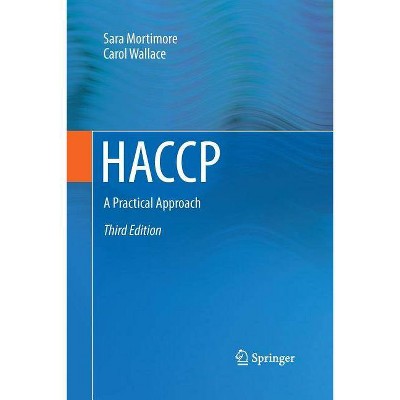Haccp - 3rd Edition by Sara Mortimore & Carol Wallace (Paperback)

Similar Products
Products of same category from the store
AllProduct info
<p/><br></br><p><b> About the Book </b></p></br></br>The third edition of this book is updated to include current best practices and new developments in HACCP, offering a compendium of up-to-date thinking and standards in development, implementation and maintenance of HACCP programs for food safety management.<p/><br></br><p><b> Book Synopsis </b></p></br></br>Foreword.- Acknowledgements.- About the Authors.- Disclaimer.- About this Book.- Prologue.- 1. An Introduction to HACCP and its role in food safety control.- 2. Preparation and planning to achieve effective food safety management.- 3. Hazards, their significance and control.- 4. Prerequisites for food safety - PRPs and Operational PRPs.- 5. Designing food safety.- 6. How to do a HACCP Study.- 7. Implementation, Verification and Maintenance for Ongoing Risk Management.- 8. Considerations for HACCP application in different supply chain sectors.- Epilogue.- References, further reading and resource materials.- Appendices.- Index.<p/><br></br><p><b> From the Back Cover </b></p></br></br><p><i>HACCP: A Practical Approach, 3<sup>rd</sup> edition</i><b> </b>has been updated<b> </b>to include the current best practice and new developments in HACCP application since the last edition was published in 1998. This book is intended to be a compendium of up-to-date thinking and best practice approaches to the development, implementation, and maintenance of HACCP programs for food safety risk reduction.</p><p>Introductory chapters set the scene and update the reader on HACCP developments over the last 15 years. The preliminary stages of HACCP, including preparation, planning and system design, are covered first, followed by a consideration of food safety hazards and their control. Prerequisite program coverage has been significantly expanded in this new edition, reflecting its development as a key support system for HACCP. The HACCP plan development, verification and maintenance chapters have also been substantially updated to reflect current practice and a new chapter on application within the food supply chain has been added. Appendices provide a new set of case studies of practical HACCP application plus two new case studies looking at lessons learned through food safety incident investigation. Pathogen profiles have also been updated by experts to provide an up-to-date summary of pathogen growth and survival characteristics that will be useful to HACCP teams.</p><p>The book is written both for those who are developing HACCP systems for the first time and for those who need to update, refresh and strengthen their existing systems. New materials and new tools to assist the HACCP team have been provided and the book discusses the current situation on issues that are still undergoing international debate, such as operational prerequisite programs. </p><p><b>Sara Mortimore</b> is the Vice President of Product Safety, Quality Assurance, and Regulatory Affairs at Land O'Lakes, Inc., USA. </p><p><b>Carol Wallace </b>is Principal Lecturer, Food Safety Management and Co-Director of the International Institute of Nutritional Sciences and Applied Food Safety Studies at the University of Central Lancashire, UK.</p><p/><br></br><p><b> Review Quotes </b></p></br></br><br><p><i>Mortimore and Wallace point out that since they last updated the book there have continued to be many failures in the food supply chain. Some of these are world renowned, many were significant national failures, and many, many more were small, isolated, and sometimes tragic events occurring in local communities all around the world. So what has gone wrong? Is HACCP not working? Sadly, the answer to this question is that it hasn't had a chance to work. Far from being "done," HACCP has been poorly implemented and under-utilized in probably the majority of food companies. Twenty years ago developments in HACCP were fairly major, and some governments saw its implementation as a remedy for all of their country's food safety issues. In reality, use of the HACCP approach does offer a practical and major contribution to the way forward, but </i><i>only </i><i>if the people charged with its implementation have the proper knowledge and expertise to apply it effectively. Whilst a new book isn't by itself going to solve that problem, the authors hope that it may help some companies to do better.</i></p><p>- Land O'Lakes, Inc., Arden Hills, MN</p><br><p/><br></br><p><b> About the Author </b></p></br></br><p><b>Sara Mortimore</b> is the Vice President of Product Safety, Quality Assurance, and Regulatory Affairs at Land O'Lakes. She is the co-author of several successful books on HACCP and food safety management. </p><p><b>Carol Wallace </b>is Principal Lecturer, Food Safety Management and Co-Director of the International Institute of Nutritional Sciences and Applied Food Safety Studies at the University of Central Lancashire, UK. She is Course Leader for postgraduate food safety and HACCP programs and works closely with international food companies and organizations for the ongoing improvement of food safety standards. </p>
Price History
Price Archive shows prices from various stores, lets you see history and find the cheapest. There is no actual sale on the website. For all support, inquiry and suggestion messagescommunication@pricearchive.us




















